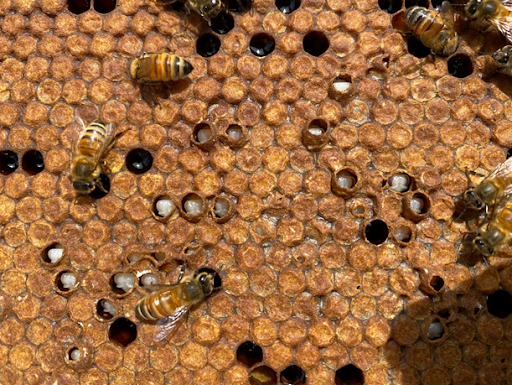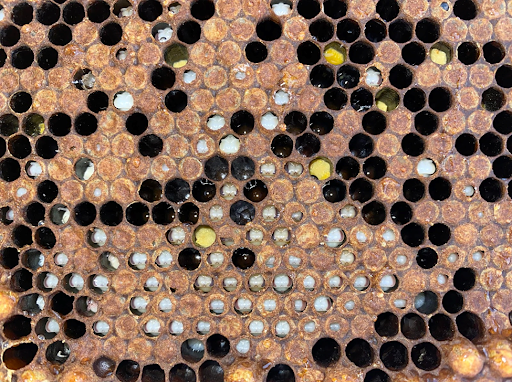By Eric Malcolm
Regular and thorough colony health inspections are critical for successful beekeeping and arguably the most important part of keeping colonies healthy. As all experienced beekeepers know, the health of colonies can change quickly. Therefore, consistent, periodic inspections are required to ensure timely management and to ensure that past management has worked.
Maryland is a relatively small state at roughly 12,400 square miles; however, according to the Maryland Department of Agriculture, we have around 1,800 beekeepers managing approximately 14,000 colonies. This means that we have over one colony per square mile in our Old Line State. Foraging can take place up to six miles from the hive. Suffice it to say, there is a LOT of shared forage, and transmissible mites and disease can rear their ugly heads at any point throughout the season.
Just like in people, early detection of disease in our bees allows for interventions that can help reduce the negative long-term impact of the disease, as well as the chances the disease will spread to neighboring colonies or apiaries.
One sign of disease all beekeepers should be aware of is the presence of young bees with crumpled and malformed wings (see image above). This is caused by high levels of infection of deformed wing virus (DWV), which is transmitted between bees in several ways: by trophallaxis, by mites feeding on bee larvae, pupae, and adults, and by vertical transmission from queen to offspring. The tell-tale “deformed wing” has been shown to be more commonly observed when introduced during development as a pupa via an infected Varroa mite. Not all colonies show visible signs of disease. However, when one sees bees with crumpled wings, as in the image above, it's a likely indicator that Varroa mite populations are high. The beekeeper needs to take immediate action to reduce the infestation.
Once a relatively rare disease, DWV is considered one of the leading causes of colony mortality and most commonly seen in colonies infested with Varroa mites. In fact, according to the 2023 APHIS National Honey Bee Pest and Disease Survey, Maryland colonies had an average of 4.3 mites/100 bees, and 92% of colonies tested positive for DWV. This emphasizes the importance of monitoring your colonies for mites regularly.
“I didn’t see any mites…,” is often the reply of beekeepers who hear this advice. Oftentimes you won’t see mites unless you use a standardized test to look for them, such as collecting a known quantity of bees and performing an alcohol wash of the sample. Beekeepers should make it a routine practice to check mite populations once a month during the active season, to ensure they remain low. When mite loads remain high, DWV levels in the colony also increase, sometimes manifesting with signs of deformed wings. This is why routine mite checks are a best practice in beekeeping.
If you see this sign, you should assume you have or recently have had high mite loads in your colony. While there is no treatment for DWV, you can prevent it from becoming a major issue in your colonies by monitoring mite loads and managing them when they exceed thresholds (1% or higher in spring, and 2% or higher in summer). Remember to do a follow up mite wash after your treatment period to confirm a successful treatment.
Maryland is a relatively small state at roughly 12,400 square miles; however, according to the Maryland Department of Agriculture, we have around 1,800 beekeepers managing approximately 14,000 colonies. This means that we have over one colony per square mile in our Old Line State. Foraging can take place up to six miles from the hive. Suffice it to say, there is a LOT of shared forage, and transmissible mites and disease can rear their ugly heads at any point throughout the season.
Just like in people, early detection of disease in our bees allows for interventions that can help reduce the negative long-term impact of the disease, as well as the chances the disease will spread to neighboring colonies or apiaries.
One sign of disease all beekeepers should be aware of is the presence of young bees with crumpled and malformed wings (see image above). This is caused by high levels of infection of deformed wing virus (DWV), which is transmitted between bees in several ways: by trophallaxis, by mites feeding on bee larvae, pupae, and adults, and by vertical transmission from queen to offspring. The tell-tale “deformed wing” has been shown to be more commonly observed when introduced during development as a pupa via an infected Varroa mite. Not all colonies show visible signs of disease. However, when one sees bees with crumpled wings, as in the image above, it's a likely indicator that Varroa mite populations are high. The beekeeper needs to take immediate action to reduce the infestation.
Once a relatively rare disease, DWV is considered one of the leading causes of colony mortality and most commonly seen in colonies infested with Varroa mites. In fact, according to the 2023 APHIS National Honey Bee Pest and Disease Survey, Maryland colonies had an average of 4.3 mites/100 bees, and 92% of colonies tested positive for DWV. This emphasizes the importance of monitoring your colonies for mites regularly.
“I didn’t see any mites…,” is often the reply of beekeepers who hear this advice. Oftentimes you won’t see mites unless you use a standardized test to look for them, such as collecting a known quantity of bees and performing an alcohol wash of the sample. Beekeepers should make it a routine practice to check mite populations once a month during the active season, to ensure they remain low. When mite loads remain high, DWV levels in the colony also increase, sometimes manifesting with signs of deformed wings. This is why routine mite checks are a best practice in beekeeping.
If you see this sign, you should assume you have or recently have had high mite loads in your colony. While there is no treatment for DWV, you can prevent it from becoming a major issue in your colonies by monitoring mite loads and managing them when they exceed thresholds (1% or higher in spring, and 2% or higher in summer). Remember to do a follow up mite wash after your treatment period to confirm a successful treatment.






 RSS Feed
RSS Feed